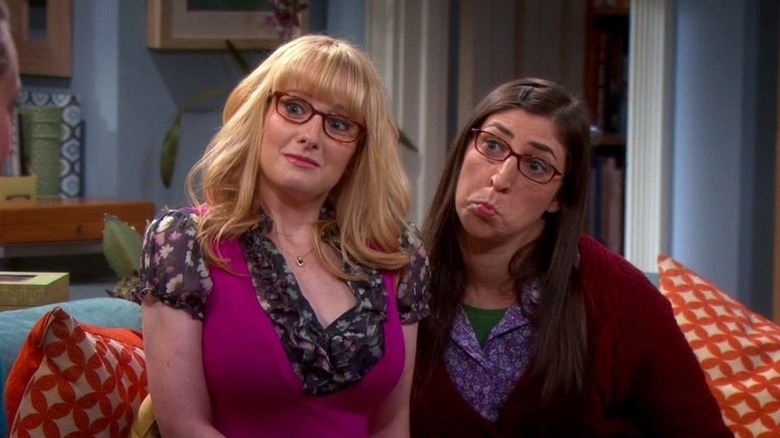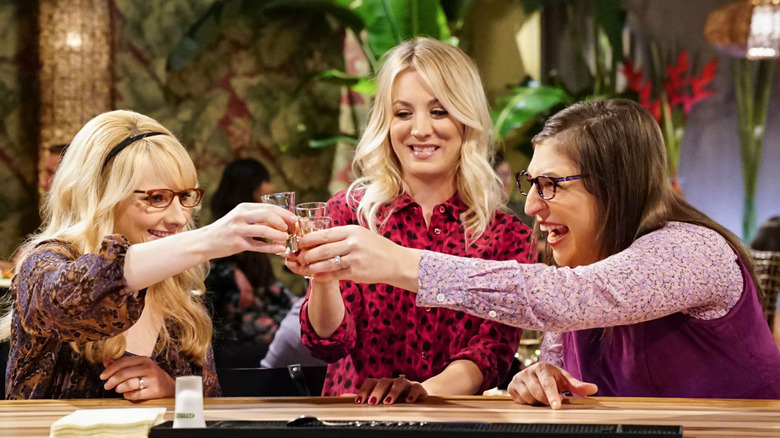
CBS
At first, the main cast of "The Big Bang Theory" was comprised of just five characters and actors: Jim Parsons as Sheldon Cooper, Johnny Galecki as Leonard Hofstadter, Simon Helberg as Howard Wolowitz, Kunal Nayyar as Raj Koothrappali, and Kaley Cuoco as Penny (who doesn't get a last name until she gets married). In season 3, two new characters and performers joined the fray — Mayim Bialik as Amy Farrah Fowler and Melissa Rauch as Bernadette Rostenkowski — and according to Helberg, they made the show much better.
In an interview with USA Today in 2013, Helberg spoke to Whitney Matheson, who pointed out that one of the greatest strengths of "The Big Bang Theory" is how much the characters evolve and deepen from season to season. Asked about why the show managed to pull that off year after year, Helberg praised the show's writers ... and two of its newest cast members.
"Yeah, I think it's a combination of the writing, which is so tasteful and smart, and the actors," Helberg said at the time. "Mayim (Bialik) and Melissa (Rauch), being brought in halfway through, (made) sort of a seamless entrance, yet also really added such an unbelievable amount of layers and dynamics to the show. It's such a hard thing to do, where all of a sudden the show is better and you can go deeper and play with the relationships. And to have that kind of success really is a testament to the writers and, specifically, Melissa and Mayim."
Simon Helberg and Jim Parsons both loved working with their new female counterparts on The Big Bang Theory

CBS
In Jessica Radloff's 2022 book "The Big Bang Theory: The Definitive, Inside Story of the Epic Hit Series," which chronicled the making of "The Big Bang Theory" and its entire 12 season run, both Simon Helberg and Jim Parsons continued singing Melissa Rauch and Mayim Bialik's praises. (Bialik and Parsons' characters Amy and Sheldon got married, as did Helberg and Rauch's characters Howard and Bernadette, meaning they were almost always working together past a certain point.)
"She really is the kindest, gentlest person," Helberg told Radloff of Rauch. "I don't know how to say it in a way that rings of clichés, but I really do mean it. I might have exploited her as some kind of makeshift therapist throughout the years because her eyes are just enveloping so you let go completely. I have a really strong memory of her first episode — that scene in the restaurant where the date happened [...] It was like having the best partner you could have. You're really only as good as your partner, so I was happy to be doing the show in tandem with her forever from then on out."
As for Parsons, he worried that Amy, originally meant as "a female version of Sheldon," might not stick around long-term ... so he decided he would fight to ensure that Amy could evolve as a character and stay on the show. "At some point I felt a certain way about working with Mayim that I was like, if for whatever reason we seemed to be weaning her off of this show as a character, I would go and talk to [the writers]," Parsons recalled. "I said this years ago, but I believe it even more now that one of the smartest things that the writers room ever did was introduce Bernadette and Amy at a point where, as far as interests and storylines go, we did not need them yet. The writers did not let the well run dry before they were like, 'Oh God, should we adopt a kid? Should we bring in a monkey?' You know what I mean? They plugged these people in to see what was going to work and how it would work, and I thought it was genius."
Amy and Bernadette added some much-needed feminine energy to The Big Bang Theory — as did some new writers

CBS
Having Penny as the only main female character on "The Big Bang Theory" proved to be a little frustrating throughout the show's first few seasons, so introducing them onto the series gave it some feminine energy that it sorely needed ... and according to Radloff's book, it also gave female writers like Tara Hernandez and Maria Ferrari more freedom to pitch and write stories for Amy, Penny, and Bernadette (who all become close friends on the show). As Hernandez recalls in the book, she pitched a storyline about Penny and Bernadette leaving Amy out of the search for bridesmaid dresses, and executive producer Steve Molaro helped her feel bold enough to start telling more female-centered stories. "Being in a gender minority in a space is always extra complicated in an already complicated job, but what I appreciated early on, especially from Steve Molaro's leadership, is he never pigeonholed us into like, you can only tell the female stories. But I know it was important for me and Maria, as well as all the writers, to explore what our female characters were passionate about. We knew what the guys were interested in, but what about the women?"
Ferrari agreed, saying that introducing two main female characters prevented "The Big Bang Theory" from tokenizing Penny. "If the premise of the show at the beginning was these guys want to meet women [...] it really treats women not as people, as if there is an exotic prize-like characteristic to them," Ferrari noted. Not only that, but Chuck Lorre's daughter Nikki, who worked on the series as a director, also said that Amy and Bernadette provided a great contrast to Penny. "Seeing women in those roles — both an awkward, painful introvert like Amy, or even someone that's kind of in between the pretty girl next door and her in Bernadette — that gave more of a breadth of the kind of characters you want to see represented on TV," Nikki Lorre explained. "It's not just the all-American guy and the girl next door, it's like, no, no, there's a lot of diversity in that cast and those characters. There was something for everyone."
"The Big Bang Theory" is currently streaming on Max.









 English (US) ·
English (US) ·